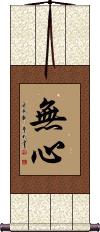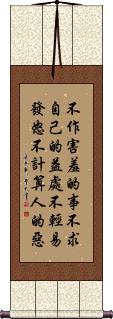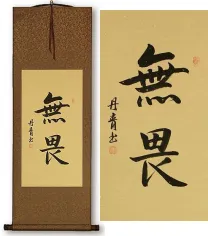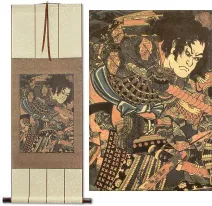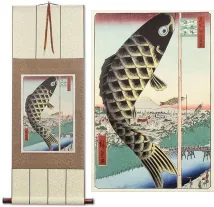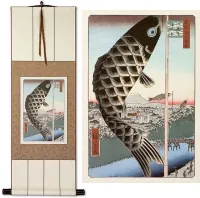Many custom options...
And formats...

The name No Evil in Chinese / Japanese...
Buy a No Evil calligraphy wall scroll here!
Personalize your custom “No Evil” project by clicking the button next to your favorite “No Evil” title below...
1 Corinthians 13:4-8
Here is 1st Corinthians 13:4-8 (just the first sentence of verse 8) in Japanese.
In the familiar NIV, this would read:
Love is patient, love is kind. It does not envy, it does not boast, it is not proud.
It does not dishonor others, it is not self-seeking, it is not easily angered, it keeps no record of wrongs.
Love does not delight in evil but rejoices with the truth.
It always protects, always trusts, always hopes, always perseveres.
Love never fails...
The Japanese text is from the 新改訳聖書 (Shinkaiyaku) or New Japanese Bible. Popular among most Protestant denominations in modern Japan.
Note: Because this selection contains some special Japanese Hiragana characters, it should be written by a Japanese calligrapher.
Fear No Evil
不怕邪惡 literally means “no fear of evil” in Chinese.
Chinese grammar and word order are a little different than English. 不怕邪惡 is the best way to write something that means “fear no evil” in Chinese.
The first character means “not,” “don't” or “no.”
The second means “fear.”
The last two mean “evil” but can also be translated as sinister, vicious, wickedness, or just “bad.”
Fear No Evil
悪を恐れない is “Fear No Evil” in Japanese.
Japanese grammar and phrase construction is different than English, so this literally reads, “Evil Fear Not.”
The “evil” Kanji can also be translated as “wickedness.”
Note: Because this selection contains some special Japanese Hiragana characters, it should be written by a Japanese calligrapher.
No Mind / Mushin
In Japanese, 無心 means innocent or without knowledge of good and evil. It literally means “without mind.”
無心 is one of the five spirits of the warrior (budo) and is often used as a Japanese martial arts tenet. Under that context, places such as the Budo Dojo define it this way: “No mind, a mind without ego. A mind like a mirror which reflects and dos not judge.” The original term was “mushin no shin,” meaning “mind of no mind.” It is a state of mind without fear, anger, or anxiety. Mushin is often described by the phrase “Mizu no Kokoro,” which means “mind like water.” The phrase is a metaphor describing the pond that clearly reflects its surroundings when calm but whose images are obscured once a pebble is dropped into its waters.
This has a good meaning in conjunction with Chan / Zen Buddhism in Japan. However, out of that context, it means mindlessness or absent-mindedness. To non-Buddhists in China, this is associated with doing something without thinking.
In Korean, this usually means indifference.
Use caution and know your audience before ordering this selection.
More info: Wikipedia: Mushin
1 Corinthians 13:5
Here is 1 Corinthians 13:5 in Chinese.
The text with punctuation:
不作害羞的事。不求自己的益处。不轻易发怒。不计算人的恶。
Hand-painted calligraphy does not retain punctuation.
This translation is from the Chinese Union Bible.
You may know it from the KJV as:
Doth not behave itself unseemly, seeketh not her own, is not easily provoked, thinketh no evil.
This in-stock artwork might be what you are looking for, and ships right away...
Gallery Price: $108.00
Your Price: $59.88
Gallery Price: $108.00
Your Price: $59.88
Gallery Price: $61.00
Your Price: $33.88
Gallery Price: $61.00
Your Price: $33.88
Gallery Price: $61.00
Your Price: $33.88
Gallery Price: $61.00
Your Price: $33.88
Gallery Price: $61.00
Your Price: $33.88
Gallery Price: $108.00
Your Price: $59.88
Gallery Price: $90.00
Your Price: $49.88
Not the results for no evil that you were looking for?
Below are some entries from our dictionary that may match your no evil search...
| Characters If shown, 2nd row is Simp. Chinese |
Pronunciation Romanization |
Simple Dictionary Definition |
佛 see styles |
fó fo2 fo hotoke ほとけ |
More info & calligraphy: Buddhism / Buddha(surname) Hotoke Buddha, from budh to "be aware of", "conceive", "observe", "wake"; also 佛陀; 浮圖; 浮陀; 浮頭; 浮塔; 勃陀; 勃馱; 沒馱; 母馱; 母陀; 部陀; 休屠. Buddha means "completely conscious, enlightened", and came to mean the enlightener. he Chinese translation is 覺 to perceive, aware, awake; and 智 gnosis, knowledge. There is an Eternal Buddha, see e.g. the Lotus Sutra, cap. 16, and multitudes of Buddhas, but the personality of a Supreme Buddha, an Ādi-Buddha, is not defined. Buddha is in and through all things, and some schools are definitely Pan-Buddhist in the pantheistic sense. In the triratna 三寳 commonly known as 三寳佛, while Śākyamuni Buddha is the first "person" of the Trinity, his Law the second, and the Order the third, all three by some are accounted as manifestations of the All-Buddha. As Śākyamuni, the title indicates him as the last of the line of Buddhas who have appeared in this world, Maitreya is to be the next. As such he is the one who has achieved enlightenment, having discovered the essential evil of existence (some say mundane existence, others all existence), and the way of deliverance from the constant round of reincarnations; this way is through the moral life into nirvana, by means of self-abnegation, the monastic life, and meditation. By this method a Buddha, or enlightened one, himself obtains Supreme Enlightenment, or Omniscience, and according to Māhāyanism leads all beings into the same enlightenment. He sees things not as they seem in their phenomenal but in their noumenal aspects, as they really are. The term is also applied to those who understand the chain of causality (twelve nidānas) and have attained enlightenment surpassing that of the arhat. Four types of the Buddha are referred to: (1) 三藏佛the Buddha of the Tripiṭaka who attained enlightenment on the bare ground under the bodhi-tree; (2) 通佛the Buddha on the deva robe under the bodhi-tree of the seven precious things; (3) 別佛the Buddha on the great precious Lotus throne under the Lotus realm bodhi-tree; and (4) 圓佛the Buddha on the throne of Space in the realm of eternal rest and glory where he is Vairocana. The Hīnayāna only admits the existence of one Buddha at a time; Mahāyāna claims the existence of many Buddhas at one and the same time, as many Buddhas as there are Buddha-universes, which are infinite in number. |
業 业 see styles |
yè ye4 yeh waza わざ |
More info & calligraphy: Karmadeed; act; work; performance; (personal name) Hajime karman, karma, "action, work, deed"; "moral duty"; "product, result, effect." M.W. The doctrine of the act; deeds and their effects on the character, especially in their relation to succeeding forms of transmigration. The 三業 are thought, word, and deed, each as good, bad, or indifferent. Karma from former lives is 宿業, from present conduct 現業. Karma is moral action that causes future retribution, and either good or evil transmigration. It is also that moral kernel in which each being survives death for further rebirth or metempsychosis. There are categories of 2, 3, 4, 6, and 10; the 六業 are rebirth in the hells, or as animals, hungry ghosts, men, devas, or asuras: v. 六趣. |
禪 禅 see styles |
shàn shan4 shan yuzuri ゆずり |
More info & calligraphy: Zen / Chan / Meditation(out-dated kanji) (1) (Buddhist term) dhyana (profound meditation); (2) (abbreviation) Zen (Buddhism); (surname) Yuzuri To level a place for an altar, to sacrifice to the hills and fountains; to abdicate. Adopted by Buddhists for dhyāna, 禪 or 禪那, i.e. meditation, abstraction, trance. dhyāna is 'meditation, thought, reflection, especially profound and abstract religious contemplation'. M.W. It was intp. as 'getting rid of evil', etc., later as 靜慮 quiet meditation. It is a form of 定, but that word is more closely allied with samādhi, cf. 禪定. The term also connotes Buddhism and Buddhist things in general, but has special application to the 禪宗 q.v. It is one of the six pāramitās, cf. 波. There are numerous methods and subjects of meditation. The eighteen brahmalokas are divided into four dhyāna regions 'corresponding to certain frames of mind where individuals might be reborn in strict accordance with their spiritual state'. The first three are the first dhyāna, the second three the second dhyāna, the third three the third dhyāna, and the remaining nine the fourth dhyāna. See Eitel. According to Childers' Pali Dictionary, 'The four jhānas are four stages of mystic meditation, whereby the believer's mind is purged from all earthly emotions, and detached as it were from his body, which remains plunged in a profound trance.' Seated cross-legged, the practiser 'concentrates his mind upon a single thought. Gradually his soul becomes filled with a supernatural ecstasy and serenity', his mind still reasoning: this is the first jhāna. Concentrating his mind on the same subject, he frees it from reasoning, the ecstasy and serenity remaining, which is the second jhāna. Then he divests himself of ecstasy, reaching the third stage of serenity. Lastly, in the fourth stage the mind becomes indifferent to all emotions, being exalted above them and purified. There are differences in the Mahāyāna methods, but similarity of aim. |
索 see styles |
suǒ suo3 so soo; sou / soo; so ソー; ソウ |
More info & calligraphy: Soe(counter) {mahj} counter for bamboo tiles; (given name) Saku Cord; to extort, express; the cord or noose of Guanyin by which she binds the good; the cord of the vajra-king by which he binds the evil; translit. sa. |
累 see styles |
lèi lei4 lei rui るい |
tired; weary; to strain; to wear out; to work hard trouble; harmful effect; evil influence; implication; involvement; (female given name) Rui To tie; accumulate; repeatedly; to implicate, involve. |
覺 觉 see styles |
jué jue2 chüeh satoru さとる |
More info & calligraphy: Awareness(personal name) Satoru bodhi, from bodha, 'knowing, understanding', means enlightenment, illumination; 覺 is to awake, apprehend, perceive, realize; awake, aware; (also, to sleep). It is illumination, enlightenment, or awakening in regard to the real in contrast to the seeming; also, enlightenment in regard to moral evil. Cf. 菩提 and 佛. |
賊 贼 see styles |
zéi zei2 tsei zoku ぞく |
More info & calligraphy: Rebel / Insurgent(1) thief; robber; burglar; (2) rebel; insurgent; traitor A thief, robber, spoiler; to rob, steal, etc. |
鬼 see styles |
guǐ gui3 kuei oni(p); ki おに(P); き |
More info & calligraphy: Ghost Demon(1) ogre; demon; oni; (2) (See 亡魂) spirit of a deceased person; (3) (おに only) ogre-like person (i.e. fierce, relentless, merciless, etc.); (4) (おに only) (See 鬼ごっこ・おにごっこ) it (in a game of tag, hide-and-seek, etc.); (5) (き only) {astron} (See 二十八宿,朱雀・すざく・2) Chinese "ghost" constellation (one of the 28 mansions); (prefix) (6) (おに only) (slang) (See 超・1) very; extremely; super-; (surname) Miniwa preta 薜荔多, departed, dead; a disembodied spirit, dead person, ghost; a demon, evil being; especially a 餓鬼 hungry ghost. They are of many kinds. The Fan-i ming i classifies them as poor, medium, and rich; each again thrice subdivided: (1) (a) with mouths like burning torches; (b) throats no bigger than needles; (c) vile breath, disgusting to themselves; (2) (a) needle-haired, self-piercing; (b) hair sharp and stinking; (c) having great wens on whose pus they must feed. (3) (a) living on the remains of sacrifices; (b) on leavings in general; (c) powerful ones, yakṣas, rākṣasas, piśācas, etc. All belong to the realm of Yama, whence they are sent everywhere, consequently are ubiquitous in every house, lane, market, mound, stream, tree, etc. |
しし see styles |
jiji ジジ |
Okinawan lion (or lion dog) statues, placed as talisman against evil at entrances and on roofs; (female given name) Gigi; Jiji |
佛心 see styles |
fó xīn fo2 xin1 fo hsin busshin |
More info & calligraphy: Buddha Heart / Mind of BuddhaThe mind of Buddha, the spiritually enlightened heart. A heart of mercy; a heart abiding in the real, not the seeming; detached from good and evil and other such contrasts. |
布施 see styles |
bù shī bu4 shi1 pu shih fuse ふせ |
More info & calligraphy: Dana: Almsgiving and Generosity(n,vs,vi) (1) {Buddh} alms-giving; charity; (n,vs,vi) (2) {Buddh} offerings (usu. money) to a priest (for reading sutras, etc.); (surname) Fuho dāna 檀那; the sixth pāramitā, almsgiving, i. e. of goods, or the doctrine, with resultant benefits now and also hereafter in the forms of reincarnation, as neglect or refusal will produce the opposite consequences. The 二種布施 two kinds of dāna are the pure, or unsullied charity, which looks for no reward here but only hereafter; and the sullied almsgiving whose object is personal benefit. The three kinds of dāna are goods, the doctrine, and courage, or fearlessness. The four kinds are pens to write the sutras, ink, the sutras themselves, and preaching. The five kinds are giving to those who have come from a distance, those who are going to a distance, the sick, the hungry, those wise in the doctrine. The seven kinds are giving to visitors, travellers, the sick, their nurses, monasteries, endowments for the sustenance of monks or nuns, and clothing and food according to season. The eight kinds are giving to those who come for aid, giving for fear (of evil), return for kindness received, anticipating gifts in return, continuing the parental example of giving, giving in hope of rebirth in a particular heaven, in hope of an honoured name, for the adornment of the heart and life. 倶舍論 18. |
悪魔 see styles |
akuma あくま |
More info & calligraphy: Akuma |
惡魔 恶魔 see styles |
è mó e4 mo2 o mo akuma |
More info & calligraphy: DemonEvil māras, demon enemies of Buddhism. |
法輪 法轮 see styles |
fǎ lún fa3 lun2 fa lun hourin / horin ほうりん |
More info & calligraphy: Eternal Wheel of Life{Buddh} (See 輪宝,転法輪) the teachings of Buddha (as likened to the Dharmachakra, originally a wheel-like weapon used to destroy the evils of mankind); Buddhist doctrine; (surname) Noriwa dharmacakra, the Wheel of the Law, Buddha-truth which is able to crush all evil and all opposition, like Indra's wheel, and which rolls on from man to man, place to place, age to age. 轉法輪To turn, or roll along the Law-wheel, i.e. to preach Buddha-truth. |
犬神 see styles |
inugami いぬがみ |
More info & calligraphy: Inugami / Dog Spirit |
精進 精进 see styles |
jīng jìn jing1 jin4 ching chin shoujin(p); soujin(ok); shouji(ok); souji(ok) / shojin(p); sojin(ok); shoji(ok); soji(ok) しょうじん(P); そうじん(ok); しょうじ(ok); そうじ(ok) |
More info & calligraphy: Devotion / Diligence / Vigorous / Energetic(n,vs,vi) (1) concentration; diligence; devotion; (n,vs,vi) (2) {Buddh} (See 六波羅蜜) asceticism; zeal in one's quest for enlightenment; (n,vs,vi) (3) adherence to a vegetarian diet; (surname) Shoujin vīrya, one of the seven bodhyaṅga; 'vigour,' 'valour, fortitude,' 'virility' (M.W.); 'welldoing' (Keith). The Chinese interpretation may be defined, as pure or unadulterated progress, i.e. 勤 zeal, zealous, courageously progressing in the good and eliminating the evil.; vīrya, zeal, unchecked progress. |
鐘馗 钟馗 see styles |
zhōng kuí zhong1 kui2 chung k`uei chung kuei |
More info & calligraphy: Zhong Kui |
正精進 正精进 see styles |
zhèng jīng jìn zheng4 jing1 jin4 cheng ching chin shoushoujin / shoshojin しょうしょうじん |
More info & calligraphy: 6. Right Effort / Right Endeavor / Perfect Effortsamyagvyāyāma, right effort, zeal, or progress, unintermitting perseverance, the sixth of the 八正道; 'right effort, to suppress the rising of evil states, to eradicate those which have arisen, to stimulate good states, and to perfect those which have come into being. ' Keith. |
不動明王 不动明王 see styles |
bù dòng míng wáng bu4 dong4 ming2 wang2 pu tung ming wang fudoumyouou / fudomyoo ふどうみょうおう |
More info & calligraphy: Fudo Myo-o / Wisdom King不動尊 Aryacalanatha 阿奢羅曩 tr. 不動尊 and 無動尊 and Acalaceta, 阿奢囉逝吒 tr. 不動使者. The mouthpiece or messenger, e. g. the Mercury, of the Buddhas; and the chief of the five Ming Wang. He is regarded as the third person in the Vairocana trinity. He has a fierce mien overawing all evil spirits. He is said to have attained to Buddhahood, but also still to retain his position with Vairocana. He has many descriptive titles, e. g. 無量力神通無動者; 不動忿怒王, etc. Five different verbal signs are given to him. He carries a sharp wisdom-sword, a noose, a thunder-bolt. The colour of his images is various—black, blue, purple. He has a youthful appearance; his hair falls over his left shoulder; he stands or sits on a rock; left eye closed; mouth shut, teeth gripping upper lip, wrinkled forehead, seven locks of hair, full-bodied, A second representation is with four faces and four arms, angry mien, protruding teeth, with fames around him. A third with necklaces. A fourth, red, seated on a rock, fames, trident, etc. There are other forms. He has fourteen distinguishing symbols, and many dharanis associated with the realm of fire, of saving those in distress, and of wisdom. He has two messengers 二童子 Kimkara 矜羯羅 and Cetaka 制吒迦, and, including these, a group of eight messengers 八大童子 each with image, symbol, word-sign, etc. Cf. 不動佛. |
善悪不二 see styles |
zenakufuni ぜんあくふに |
More info & calligraphy: Good and Evil |
彰善癉惡 彰善瘅恶 see styles |
zhāng shàn dàn è zhang1 shan4 dan4 e4 chang shan tan o |
More info & calligraphy: Distinguish Good and Evil |
悪因悪果 see styles |
akuinakka あくいんあっか |
More info & calligraphy: Evil Cause, Evil Result |
儺 傩 see styles |
nuó nuo2 no na な |
to exorcise demons (archaism) (See 追儺) (ceremony of) driving out evil spirits |
兇 凶 see styles |
xiōng xiong1 hsiung kyou / kyo きょう |
terrible; fearful (out-dated kanji) evil; wickedness |
凶 see styles |
xiōng xiong1 hsiung kyō きょう |
vicious; fierce; ominous; inauspicious; famine; variant of 兇|凶[xiong1] (1) bad luck; bad fortune; (2) evil; wickedness bad fortune |
厄 see styles |
è e4 o yaku やく |
distressed (1) misfortune; bad luck; evil; disaster; (2) (abbreviation) (See 厄年・1) unlucky year; critical year; year (esp. age 25 and 42 for men, 19 and 33 for women) that is considered unlucky misfortune |
否 see styles |
pǐ pi3 p`i pi hi ひ |
clogged; evil no; the noes no, not |
唼 see styles |
shǎ sha3 sha |
to speak evil; gobbling sound made by ducks |
孽 see styles |
niè nie4 nieh getsu |
son born of a concubine; disaster; sin; evil Retribution; an illicit son; son of a concubine. |
害 see styles |
hài hai4 hai gai がい |
to do harm to; to cause trouble to; harm; evil; calamity injury; harm; evil influence; damage hiṃsā; vihiṃsā; hurt, harm, injure. |
Click here for more no evil results from our dictionary
The following table may be helpful for those studying Chinese or Japanese...
| Title | Characters | Romaji (Romanized Japanese) | Various forms of Romanized Chinese | |
| 1 Corinthians 13:4-8 | 愛は寛容であり愛は親切ですまた人をねたみません愛は自慢せず高慢になりません礼儀に反することをせず自分の利益を求めず怒らず人のした悪を思わず不正を喜ばずに真理を喜びますすべてをがまんしすべてを信じすべてを期待しすべてを耐え忍びます愛は決して絶えることがありません | ai wa kan youdeari ai wa shinsetsudesu mata hito o netamimasen ai wa jiman sezu kouman ni narimasen reigi ni hansuru koto o sezu jibun no rieki o motomezu okorazu hito no shita aku o omowazu fusei o yorokobazu ni shinri o yorokobimasu subete o gaman shi s ai wa kan yodeari ai wa shinsetsudesu mata hito o netamimasen ai wa jiman sezu koman ni narimasen reigi ni hansuru koto o sezu jibun no rieki o motomezu okorazu hito no shita aku o omowazu fusei o yorokobazu ni shinri o yorokobimasu subete o gaman shi s | ||
| Fear No Evil | 不怕邪惡 不怕邪恶 | bú pà xié è bu2 pa4 xie2 e4 bu pa xie e bupaxiee | pu p`a hsieh o pupahsieho pu pa hsieh o |
|
| Fear No Evil | 悪を恐れない | aku o osore nai akuoosorenai | ||
| No Mind Mushin | 無心 无心 | mu shin / mushin | wú xīn / wu2 xin1 / wu xin / wuxin | wu hsin / wuhsin |
| 1 Corinthians 13:5 | 不作害羞的事不求自己的益處不輕易發怒不計算人的惡 不作害羞的事不求自己的益处不轻易发怒不计算人的恶 | bù zuò hài xiū de shì bù qiú zì jǐ de yì chu bù qīng yì fā nù bù jì suàn rén de è bu4 zuo4 hai4 xiu1 de shi4 bu4 qiu2 zi4 ji3 de yi4 chu bu4 qing1 yi4 fa1 nu4 bu4 ji4 suan4 ren2 de e4 bu zuo hai xiu de shi bu qiu zi ji de yi chu bu qing yi fa nu bu ji suan ren de e | pu tso hai hsiu te shih pu ch`iu tzu chi te i ch`u pu ch`ing i fa nu pu chi suan jen te o pu tso hai hsiu te shih pu chiu tzu chi te i chu pu ching i fa nu pu chi suan jen te o |
|
| In some entries above you will see that characters have different versions above and below a line. In these cases, the characters above the line are Traditional Chinese, while the ones below are Simplified Chinese. | ||||
Successful Chinese Character and Japanese Kanji calligraphy searches within the last few hours...



